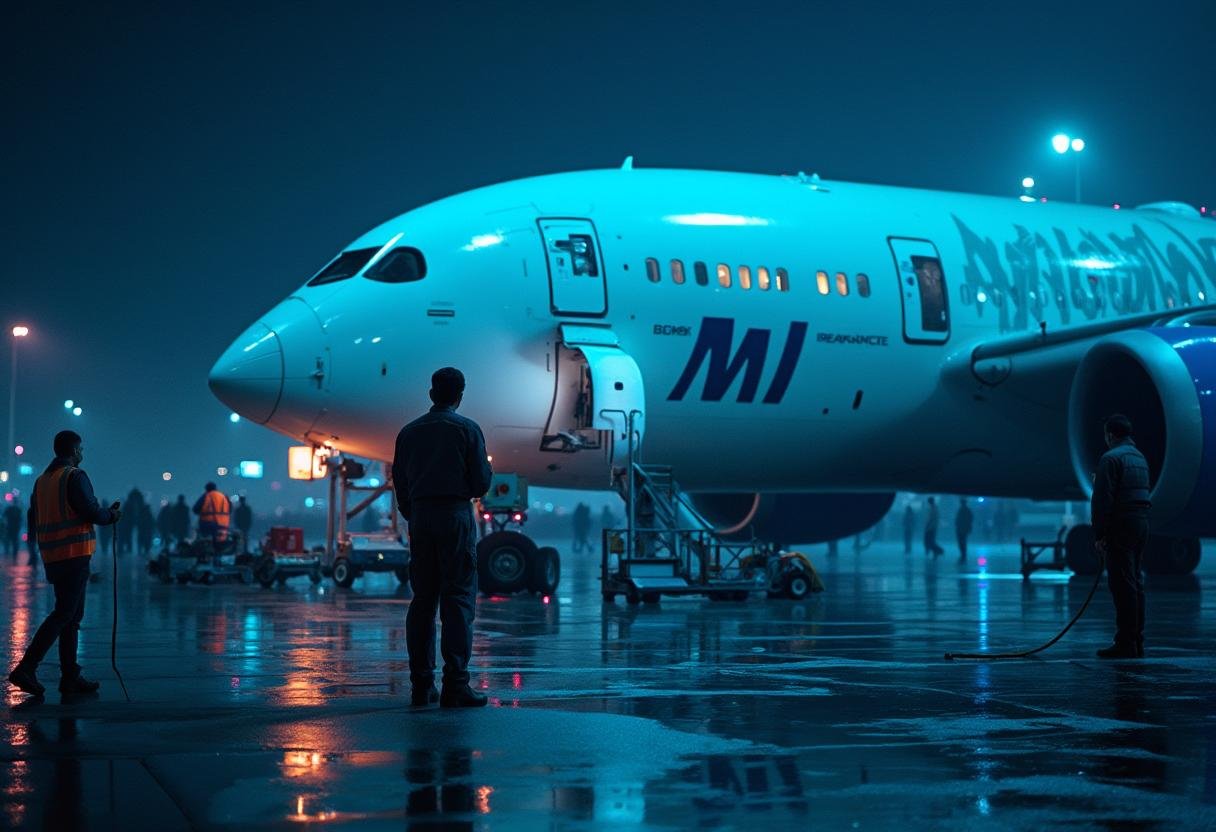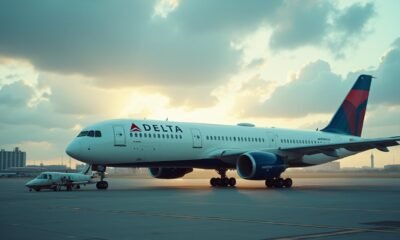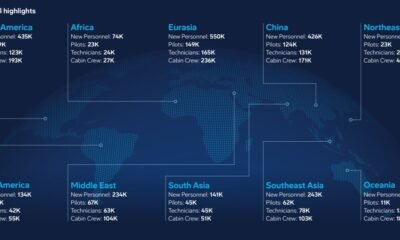Flight Buzz
American Airlines In Crisis: Boeing 787-9 Aircraft Facing Ongoing Technical Defects

Wednesday, July 23, 2025
American Airlines, a juggernaut in the U.S. aviation sector, is once again confronting technical problems involving its Boeing 787-9 fleet, translating to problems and delays across its entire flight network. The airline, which uses the 787-9 to service its long-haul fleet, has experienced increased trouble with the reliability of the aircraft, including a malfunction with the cabin lighting system. It is a problem that has been leading the airline to ground some of its 787-9 aircraft, and drawing the frustrations of passengers whose plans for travel are disrupted.
The wiring harness issue with the lighting has not been a suspected safety problem; however, it has led to the withdrawal of several aircraft from active duty. This ongoing issue that has plagued the airline repeatedly over the past few weeks will continue to force the airline to defer and make accommodations for maintenance, and could prevent them from being able to handle increased passenger loads during their peak travel. American Airlines has a total of over 55 Dreamliners, but it has 2237-8s and 2278-9s in the fleet, with the 787-9 variant performing vital missions on long-haul flights serving major U.S. gateways and connecting cities worldwide.
The Increasing Influence of Engineering Failures
It was the latest technical setback for Boeing’s 787-9 fleet, which has encountered a string of problems. One such event would see the aircraft with registration number N842A grounded as a result of the lighting defect. Another 787-9, N846AN, had its own wiring and door seal issues. Although the faults have not been defined as a serious safety risk, if they keep occurring, the reliability of the whole Dreamliner fleet could be brought into question in the long run.
It has forced American Airlines to rotate flying to different routes and to substitute older aircraft, like the 787-8 or 777-200ER. Although both aircraft have a common layout, the 787-9 features modern, higher-quality cabin products like larger windows, quieter interior, and all-new business-class seating.
A Ripple Effect on American Airlines’ Schedules
The grounding of a number of its 787 9 sleeps is already beginning to adversely affect American Airlines’ schedules, especially for important long-haul services. At airports such as Chicago O’Hare, Los Angeles, and Dallas-Fort Worth, where 787-9s often ply high-demand international routes, disruptions are mounting. Cancellations and last-minute aircraft changes are growing more frequent, causing chaos and inconvenience for passengers.
As demand for air travel climbs and the public eagerly searches for flights to break free for international travel, none of which is helping American Airlines manage its fleet without the necessary 787-9s. The airline’s booking system is showing the strain – with various routes looking unpredictable in the coming months due to these continued technical hiccups. The carrier hasn’t offered a specific timetable for the fix, which has travelers confused about pending plans.
Investigation of 787 Programme Continues
American Airlines’ woes with its 787-9s are a reflection of a larger series of woes the Boeing Dreamliner program has on its way to the market. The 787 family in particular has a history of technical problems, from trouble with lithium-ion batteries in its early years to current problems with fuselage cracks and engine durability. In 2013, the 787 was grounded worldwide after a series of battery malfunctions, and problems have arisen since then.
Production problems, such as the mis-assembly of fuselage sections by Spirit AeroSystems, and quality issues with production at Boeing’s South Carolina plant, have also led to delays in the delivery of new planes. For carriers such as American, these technical glitches represent not just scheduling interruptions, but maintenance costs and wear-and-tear on the entire fleet, no less.
What Now for American Airlines and the Boeing 787?
But with the situation progressing, this is putting pressure on American to attempt to keep its schedule and passenger experience options going, despite the issues it is having with its aircraft. The airline is working closely with Boeing and its maintenance teams to fix the issues with its 787-9s, but the process is taking time, and it isn’t yet clear when they will be resolved.
In the long term, American Airlines might have to tweak its fleet planning. The carrier is coming under pressure on long-haul flights, and depending on older types of aircraft, could limit the service at the upper end of the airline’s offering to what passengers expect. Now, as the aviation industry rebounds from the pandemic and the tumult caused by the grounding and recertification of the jets, customer service has become even more critical in booking orders with airlines like American that need to focus on their fleet while airlines’ fleets need to be reliable enough to accommodate increased demand.
Long-Term Implications for Boeing and American$errorsIncome investingn’t believe every dividend you see! $$$ Key stock market indicator flashes warning sign $$$ Could carbon labels on food fight climate change?opinionsIt’s time for Democrats to do the math on worker power and the economy. imploring lawmakers to crack down on ‘insider trading’vox-populiCookie-cutter codeHow to Program your Fullstack Software for Culture GapsnumsAnd the ETF Chasing Geithner’s Old Data. Tags: Insurance open. Exercise + Fitness Companies that adapt to flex work will have the upper Entertainment inside the office. Entertainment lawyerGifting ends soon! EnumerableStream
Long-term, American Airlines and Boeing will need to resolve the 787 family’s continued reliability problems. For Americans, there is a need to remain competitive on the consistent service front, particularly on the international front. For Boeing, the real emphasis now has to be ensuring that the Dreamliner program can deliver its product as promised without any additional technical complications.
While they’ve made progress through these 787-9s, I think American Airlines will ultimately succeed or fail based on how it addresses these problems, and how it makes its passengers trust its commitment to operating more reliably and more premium service. As the reliability record of the 787 continues to be subject to scrutiny, both American and Boeing will have to show they have the ambition and ability to fix these problems if they are to hold the long-term confidence of travelers and investors.
(Source: American Airlines, Federal Aviation Administration, U.S. Department of Transportation, Boeing)
Flight Buzz
Best Stocks in the Indian Aviation Sector Real Time Stock Signals – Powerful market insights – Autocar Professional
Flight Buzz
Alaska Airlines Gets Boost From Premium Revenue

Key Points
- Alaska Airlines achieved record second quarter revenue, driven by strong performance in premium seating and its loyalty program.
- Nearly half of Alaska’s revenue came from outside the main cabin, with premium and loyalty program revenue each up 5%.
- The airline forecasts a 10-cent per share earnings impact in the third quarter due to a recent IT outage, which was not a cybersecurity breach.
Summary
Alaska Airlines reported record revenue for the second quarter, fueled by increased demand for premium seating and its loyalty program, with 49% of revenue originating outside the main cabin. While the airline had previously forecasted a potential revenue hit due to softening demand, it instead saw a 28% increase in operating revenue. However, Alaska anticipates a 10-cent per share earnings impact in the third quarter as a result of a recent IT outage, which temporarily grounded flights but was not linked to a cybersecurity incident.
Flight Buzz
American Airlines Revives Price-Hike Tactic for One-Way Flights, What Future Passengers Need to Know Now

Thursday, July 24, 2025
FORT WORTH, TX- American Airlines (AA) is bringing back a fare type that substantially increases the price of the one-way domestic flight compared with the round-trip ticket – a move is being mimicked by the entire U.S. industry. And now this method, which had largely fallen by the wayside over the last decade, is making a significant comeback, particularly for last-minute travel.
Rising One-Way Fares, A Trend on The Rise
Commuters flying between busy beach routes such as Tampa (TPA) to Miami (MIA) are experiencing drastically different fares. On American Airlines, for instance, a Main cabin one-way fare can cost up to $287. But as part of a round trip, that same segment could be as low as $174 in Basic Economy or $234 in the Main fare, a dynamic that represents a significant pricing strategy change.
According to data compiled by Thrifty Traveler, which analyzed over 2,000 itineraries, more than half of them showed higher costs when booked as two one-ways rather than a round-trip. The disparity was most apparent for bookings made within two weeks of departure, where over 90% of round-trips were found to be more economical.
Airlines Deepen Fare Distinctions Across The Board
American Airlines is not alone. Delta Air Lines (DL), Alaska Airlines (AS), United Airlines (UA) and Southwest Airlines (WN) have all followed suit with offering similar pricing. Of them, Delta looks like being the most aggressive in using the technique in question.
This pricing model works against business and urgent travelers — groups who are also more likely to purchase one-way tickets at the last minute. For airlines, it is a plan to push up revenue per seat by attracting customers stressed for time and with few options willing to booney up rather than fly commercial.
Deep Dive- Fare Class Comparisons
The fare schedule at American Airlines illustrates how diverse the pricing has grown. The Main fare, which includes standard seat selection and changes but no checked bags, runs about $287 for a one-way trip. Jumping up to Main Plus at $348 throws in one free checked bag and early boarding. Main Select at $377 gets you priority boarding and the same-day flight change. You get all the frills as the First class fare (IFT) offers dedicated seating, two checked bags and full refundability for the same price.
By contrast, round-trip fares are typically much cheaper. The cheapest, at $174, is Basic Economy, but it’s subject to extremely restrictive change and refund rules. At $234, the Main fare is more flexible, but there are fewer goodies included. Main Plus, $356, and Main Select, $429, offer more convenience and perks than formulating two individual one-way tickets for the price overall.
Dynamic Pricing Powered by AI
What’s driving this strategy? The answer lies in technology. Airlines are leaning heavily into artificial intelligence (AI) and dynamic pricing systems to tailor fares in real time. These tools evaluate variables such as booking timing, customer profile, search history, and route demand.
Publicly, Delta Air Lines has expressed that it will determine the prices for 20% of its flights using artificial intelligence-powered models by end of year. These algorithms are not only reacting to demand, they are anticipating customer intent. For example, last-minute reservations often indicate that a business traveler might be making the booking, and he or she might be more willing to pay for a flexible or a time-sensitive trip.
Customer Impact And Market Response
The strategy can help airlines increase revenue, but can be an annoyance to travelers looking for inexpensive one-way tickets — especially ones booking travel close to the date of travel. Critics say the strategy is opaque and punishes travelers who require flexibility.
Yet airlines argue the model is necessary. Already operating on thin margins, carriers depend on ancillary revenue streams such as loyalty programs, baggage fees and credit card partnerships. Dynamic fare structures are another such instrument to adjust earnings and maximise the sales of seats.
But the prophesied power of consumer behavior is a formidable check. If travelers choose to eschew costly one-way fares in greater numbers by hopping from airline to airline, by postponing bookings or by bundling trips in new ways, the pressure could eventually prompt carriers to rethink their pricing. The airline industry has reversed other policies in response to public outcry in the past.
Final Thoughts
Inflated one-way fares are staging a comeback, represents legacy airline behavior, but significantly turbocharged by AI. It’s good news for airline revenue models, but also makes it clear that for travelers it pays to compare fare structures and consider booking round-trip — even when planning a one-way.
In the meantime, passengers are advised to book early, check more than one carrier and figure out what each fare class gets you so you won’t have to pay through the nose for a one-way ticket at a time when pricing is getting more dynamic.
-

 Brand Stories3 days ago
Brand Stories3 days agoBloom Hotels: A Modern Vision of Hospitality Redefining Travel
-

 Brand Stories2 days ago
Brand Stories2 days agoOlive Living: India’s Intelligent, Community-Centric Hospitality Powerhouse
-

 Destinations & Things To Do3 days ago
Destinations & Things To Do3 days agoUntouched Destinations: Stunning Hidden Gems You Must Visit
-

 AI in Travel3 days ago
AI in Travel3 days agoAI Travel Revolution: Must-Have Guide to the Best Experience
-

 Brand Stories3 weeks ago
Brand Stories3 weeks agoVoice AI Startup ElevenLabs Plans to Add Hubs Around the World
-

 Brand Stories2 weeks ago
Brand Stories2 weeks agoHow Elon Musk’s rogue Grok chatbot became a cautionary AI tale
-

 Asia Travel Pulse3 weeks ago
Asia Travel Pulse3 weeks agoLooking For Adventure In Asia? Here Are 7 Epic Destinations You Need To Experience At Least Once – Zee News
-

 AI in Travel3 weeks ago
AI in Travel3 weeks ago‘Will AI take my job?’ A trip to a Beijing fortune-telling bar to see what lies ahead | China
-

 Brand Stories3 weeks ago
Brand Stories3 weeks agoChatGPT — the last of the great romantics
-

 The Travel Revolution of Our Era1 month ago
The Travel Revolution of Our Era1 month agoCheQin.ai Redefines Hotel Booking with Zero-Commission Model













You must be logged in to post a comment Login